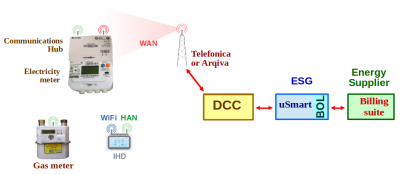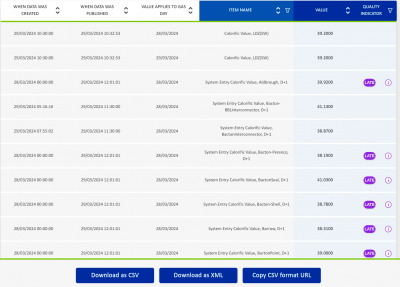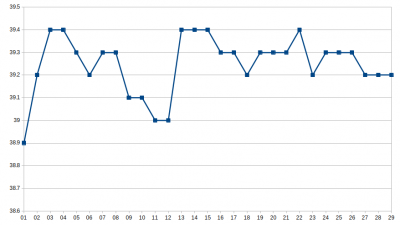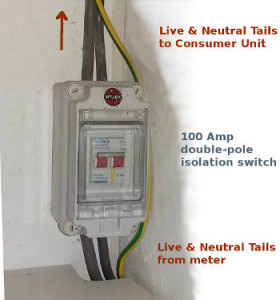Yes. The only route to communicate commands to a Smart Meter and receive data from its registers is via DCC.
All communications paths in/out of DCC are encrypted.
Each Energy Supplier (or other customer of DCC) must implement a secure pathway from their in-house billing software to DCC using a Business Orchestration Layer (BOL).
In practice many 'buy in' that interface from the likes of ESG/Utilisoft, who manage the security aspects on their behalf.
Posted by: @ianmk13Do third parties (e.g. n3rgy) access meter data through the DCC in the same way?
Yes. However little data you wish to pass through DCC, each party must
- be a member/shareholder of the Smart Energy Code (SEC)
- undergo a data security audit by an independent 3rd party, which takes several months
The calibre of security in the national Smart Meter network is very strong, and is overseen by the National Cyber Security Centre (NCSC).
That's in sharp contrast to the way in which many Energy Suppliers actually ensure the validity of the consumption data which they retrieve.
If there's an error, it's far more likely to be within the Billing System software than the Smart Meter architecture itself.
Billing software still seems to have few 'sanity checks' within it.
The Smart Meter errors which so often get reported by the press, are unfairly tarnishing the reputation of the Smart Meter network and its design.
If the in-house billing software
- retrieves the day's consumption figures from the Comms Hub before the GSME has transmitted the 48th reading of that day
- incorrectly estimates usage for a period when consumption data is missing
- bills a householder for consumption which is more than double the forecast figure
... then that's not a fault of the Smart Meter system!
Posted by: @ianmk13I'm surprised, though, that the communications protocol between the GSME and Gas Proxy in the Communications Hub isn't more robust, to include a verification message back from the GSME to confirm a correct upload of data.
The GSME operates on the Home Area Network (HAN).
This usually operates at 2.4GHz, using a secure derivative of the Zigbee communications protocol (v2.5).
Not only is it secure and robust, but it incorporates a 4-way handshake with acknowledgements that include CRC (Cyclic Redundancy Check) to ensure data integrity.
If your Energy Supplier's billing software hasn't incorporated common-sense rules to verify that it has retrieved 48 gas-consumption readings within a 'sanity window' then that's not the Smart Meter's error!
Of course there will be glitches and drop-outs in wireless communication routes from time to time.
If you place a metal dustbin between your GSME and the Comms Hub, then don't be surprised if no data gets through!
Posted by: @ianmk13Whereas I can usually get gas volume figures to tally, getting my kWh figures to agree with my bill is another matter.
There are 69 gas supply sampling points in the UK which report the Calorific Value (CV) by noon on the following day.
You can obtain this data directly from the National Grid Gas Data Portal which looks like this
Further sample points are based out in the regions.
That data is combined to provide a CV for each of the 19 gas regions of the UK.
Each Energy Supplier imports that CV data, selects the test point(s) which apply to your Meter Point Reference Number (from the location database held by Xoserve) and apply it to the reading they obtained from your Smart Meter for the previous day.
Prior to noon, it's likely that your gas consumption will have been calculated based on a 'typical' CV of around 39.2MJ/cu.m, which is probably also used on your IHD.
If 'the system' fails to obtain a valid reading, then the Supplier must create your bill based on the lowest possible CV of 37MJ/cu.m.
Save energy... recycle electrons!
To derive a gas bill in kWh from the meter readings in m³ (cubic metres)
x 1.02264 (volumetric correction - a constant, based on barometric pressure and temperature)
x CV (the calorific value for that day to 1 decimal place)
÷ 3.6 (convert to kWh)
Here's the CV for my region (SW England) during March 2024
I grabbed that data before noon today (29th).
So the figures for today and yesterday (28th) are defaulting to 39.2MJ/m³ and will get corrected later.
Save energy... recycle electrons!
@transparent So in short, I don't stand a snowball's chance in hell if accurately verifying my gas bill 🤣 🤣 🤣 . I had been trying to use my regional gas calorific value from the National Grid Gas Data Portal and the conversion factor to replicate my bill but it seems there are too many known unknowns. The daily breakdown of my bill reads like a work of fiction, although my calculation of the monthly total is within half a percent. For my own sanity, I think I'll continue to use my own calculated figures for power and energy while I continue to use gas.
@ianmk13 Never mind the ‘Unknown Knowns’ 😉
I have several apps that indicate my electrical consumption and export; I find that the reports of my export are somewhat lower on the apps than from my SMETS1 meter reports to the DCC. I am sure the meter is more accurate than my apps and so leave it that way! Regards, Scrooge err… I mean Toodles.
Toodles, heats his home with cold draughts and cooks food with magnets.
Posted by: @ianmk13I had been trying to use my regional gas calorific value from the National Grid Gas Data Portal and the conversion factor to replicate my bill but it seems there are too many known unknowns.
It should be possible to verify your gas bill by using a 'rolling' spreadsheet.
You'd have to insert formulae that apply adjustments
- after noon the following day, once the CV has been published
- after any day when all 48 readings weren't obtained
- after any period of multiple days when no data was collected at all (WAN fault)
The advantage of doing this in your own spreadsheet is that you can keep separate columns for the original readings/calculations, and those which you adjusted.
That's a problem with the way gas bills are presently provided to consumers.
The Energy Suppliers overwrite the original readings with the adjusted figure.
You can't tell which figures are
- tentative (pending an actual CV being available)
- an estimate (based on some unknown time period)
- a final figure with all adjustments applied
Using different colours for these categories would help!
On the plus side, there are fewer billing errors for gas consumption than there are for electricity for houses with Smart Meters †
I have provided the statistical analysis for electricity billing errors to the Commons Select Committee for Energy.
They forwarded the document to DESNZ... who have been investigating by writing to Energy Suppliers.
That process needs following up.
My MP is aware.
† Gas consumption is measured against a static price.
Electricity consumption might be assigned to different price points throughout the day (eg Economy-7), and those periods aren't synchronised to UTC
Save energy... recycle electrons!
@transparent I have tried this for my billing period since 9th February. Whilst I have half-hourly meter readings from the National Grid Gas Data Portal, I only have daily energy readings, in kWh, from my supplier. Correlating the data sets would be quite time-consuming, I think, particularly when one of my known unknowns is the calorific value. Xoserve data places Milton Keynes in LD Zone SO (South) whereas Energy Solutions data places Milton Keynes in LD Zone EA (East Anglia). My calculations suggest it to be likely that my supplier uses CV data (and charging rates) for LD Zone EM (East Midlands).
OK. So the problem stems from your Energy Supplier not giving you the raw consumption figures.
You are only presented with the kWh figures after they may (or may not) have applied the CV and corrections.
Have I understood that correctly?
Coincidentally I've just written to the Financial Conduct Authority on the matter of energy bills.
I believe that energy contracts & payments fall within their remit.
Save energy... recycle electrons!
Posted by: @transparentHave I understood that correctly?
Yes, I think so.
To be fair, I had downloaded my half-hourly data from n3rgy rather than my supplier's portal, but I have just done so now and for the February-March billing period the gas volume figures are identical. Using any of the 3 calorific value data sets I am unable to arrive at the same figures. Other potential known unknowns are the resolution of my supplier's various calculations and any rounding errors. These shouldn't account for the best part of half a percent difference, though.
I can't complain, though. Being on a tracker tariff, I'm already paying significantly less than the standard rate for my gas. As I said above, I am keeping a close watch on my energy consumption as I plan to transition to an ASHP - which I can't just justify on cost grounds alone at present 🙄
With so many new heat pump tariffs coming on stream, we're revisiting getting a smart meter installed to cut running costs. Have contacted E.ON today to check availability. Their website says anytime this week, but when you book and schedule an appointment we get errors from the system, so I emailed them. Will be very interested to see how this process goes.
Get a copy of The Ultimate Guide to Heat Pumps
Subscribe and follow our YouTube channel!
Please keep us updated on progress.
There are several stages in the process before a technician even arrives on site.
Each installer can typically manage four sites per day, especially in rural areas.
The network coverage database is consulted for your location.
That allows the team to allocate the right type of Communications Hub for you, and an external aerial if required.
Even if you have good signal coverage, an external aerial is sometimes still fitted in order to create a Mesh Network with other Comms Hubs in the area.
On arrival there are some pre-installation checks.
That obviously includes the existing Service Fuse and its feeder cable from the local substation.
There are about 30 possible fault codes which might apply, with ten of them being serious enough that the Installer must call the DNO for your region and remain on-site until an engineer arrives.
Your Consumer Meter will be checked for compliance before being switched off.
If you don't already have one, this is the right time for a separate double-pole 100A isolator to be fitted between the meter and the Consumer Unit.
That allows an electrician to work on your Consumer Unit without having to 'pull the Service Fuse' in future.
Save energy... recycle electrons!
- 26 Forums
- 2,364 Topics
- 53.6 K Posts
- 267 Online
- 6,027 Members
Join Us!
Worth Watching
Latest Posts
-
RE: Grant Aerona: Is there a setting to keep the 2-port valve open during pump blockade
Depends on OAT. Mine cycles at OAT>10 and of course...
By JamesPa , 1 hour ago
-
RE: Heat Pump Heats the House… But It’s Not Cosy. Emitter Changes or System Tweak?
Thanks everyone for your responses and apologies for th...
By alastair , 1 hour ago
-
RE: Solis S6-EH1P8K-L-PLUS – Why I Chose It and What I’ve Learned So Far
@energy9165 I too had this concern with the...
By Bash , 2 hours ago
-
RE: Setback savings - fact or fiction?
Well of course I agree. There is a small saving in ene...
By JamesPa , 2 hours ago
-
RE: New Fogstar 15.5kWh upright solution
@transparent My conclusion is as you have noted, tha...
By Bash , 2 hours ago
-

That makes sense to me,although we don't know what the ...
By Transparent , 4 hours ago
-
RE: Mitsubishi Ecodan R290 10kW performance
And to you too. Wishing you a very enjoyable festive s...
By Sheriff Fatman , 4 hours ago
-

RE: External pipework insulation
They do? But that isn't apparent from the photos we'r...
By Transparent , 6 hours ago
-
RE: My Powerwall 3 Consumes 3-4 kWh/Day in Self-Consumption: Is This Normal?
@editor Thank you so much for looking into this for me ...
By Caron , 7 hours ago
-
RE: Speedcomfort radiator fans
Too expensive IMHO for a whole house, at this point do ...
By JamesPa , 8 hours ago
-

RE: Say hello and introduce yourself
@velcro welcome to the forums. Please feel free start a...
By Mars , 20 hours ago
-
Daikin EDLA11D3V3 DHW Settings
I have a newly installed EDLA11D3V3 which I'm still get...
By Velcro , 21 hours ago
-

@jamespa I have found that it comes as a shock when we ...
By Toodles , 23 hours ago
-

RE: Need Help Optimising My Rushed ECO4 Install: 12kW Bosch Heat Pump
Hi @mickamills . Welcome to the forum. It sounds like...
By bontwoody , 1 day ago
-
RE: Midea ASHP – how to set weather compensation
@curlykatie did you get sorted with this?
By MickaMills , 1 day ago
-
RE: Octopus Cosy Heat Pump Owners & Discussion Thread
The FT levels off at either the set point OR the minimu...
By AndrewJ , 2 days ago
-
RE: MyVaillant Connect Regular Disconnect
Thanks. Yes, if the time is consistently 11pm every nig...
By buckwem , 2 days ago
-
RE: Who's your electricity provider and what's your tariff?
@transparent Thanks, this helps. Could it be that St...
By Batpred , 2 days ago










